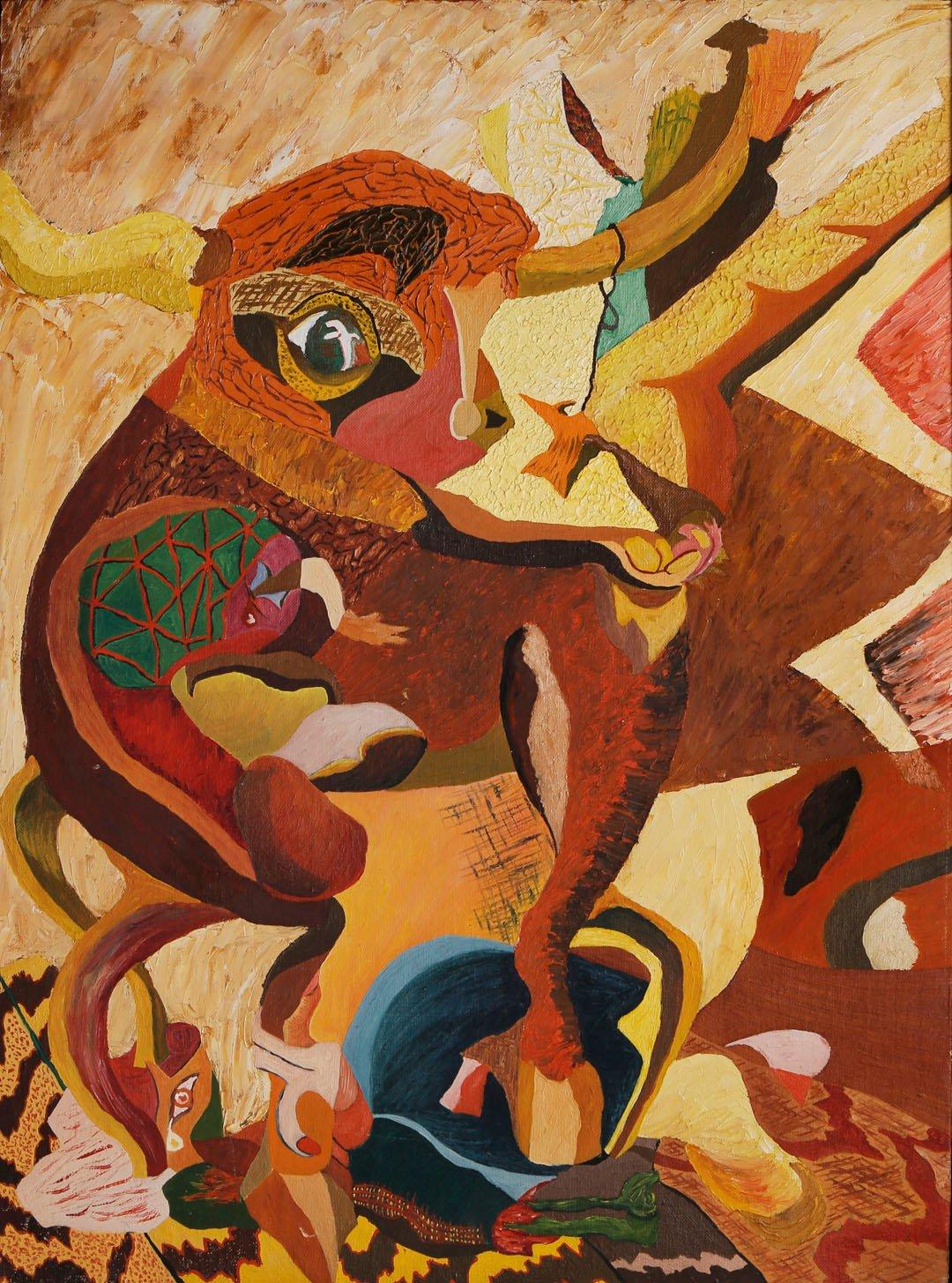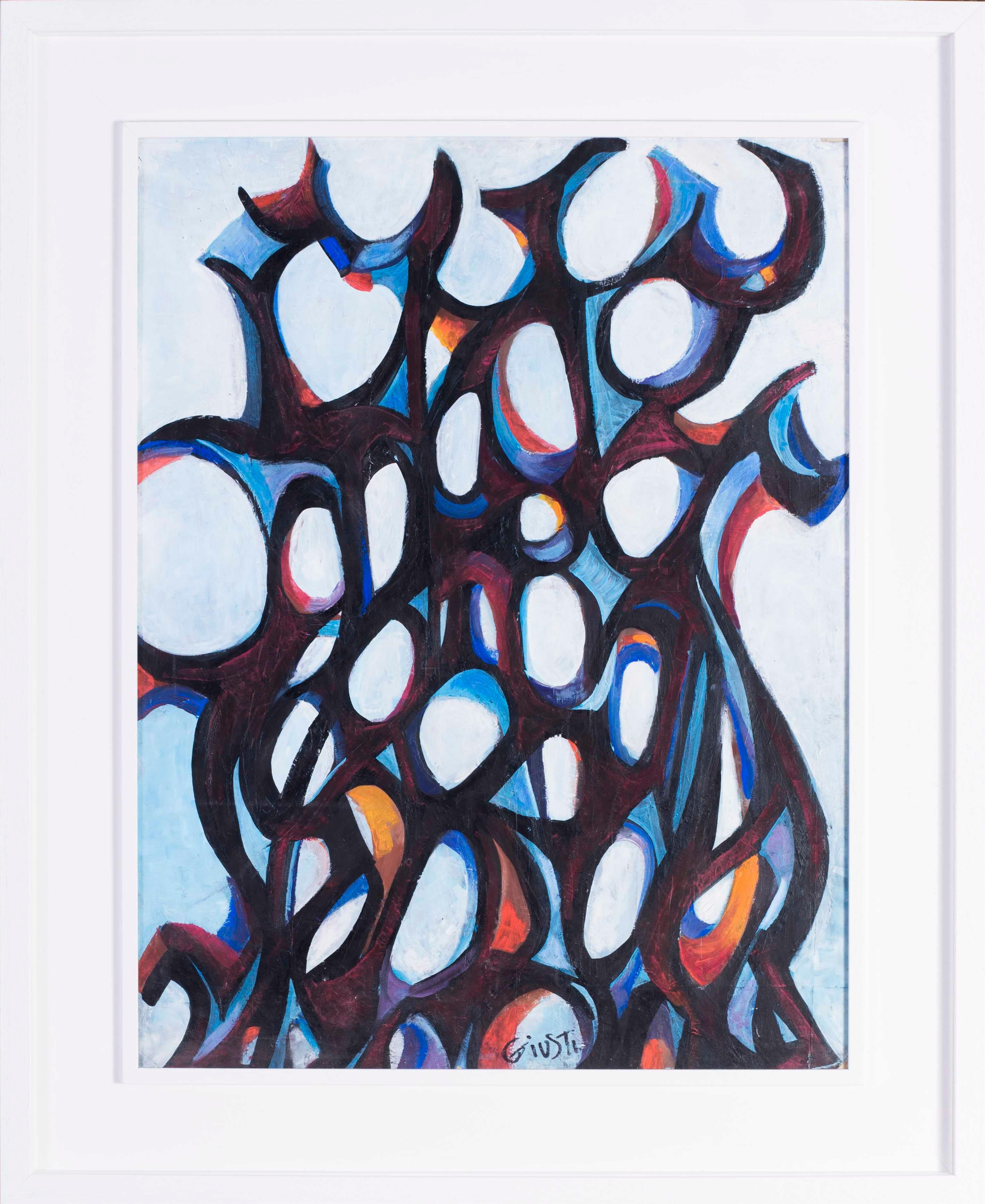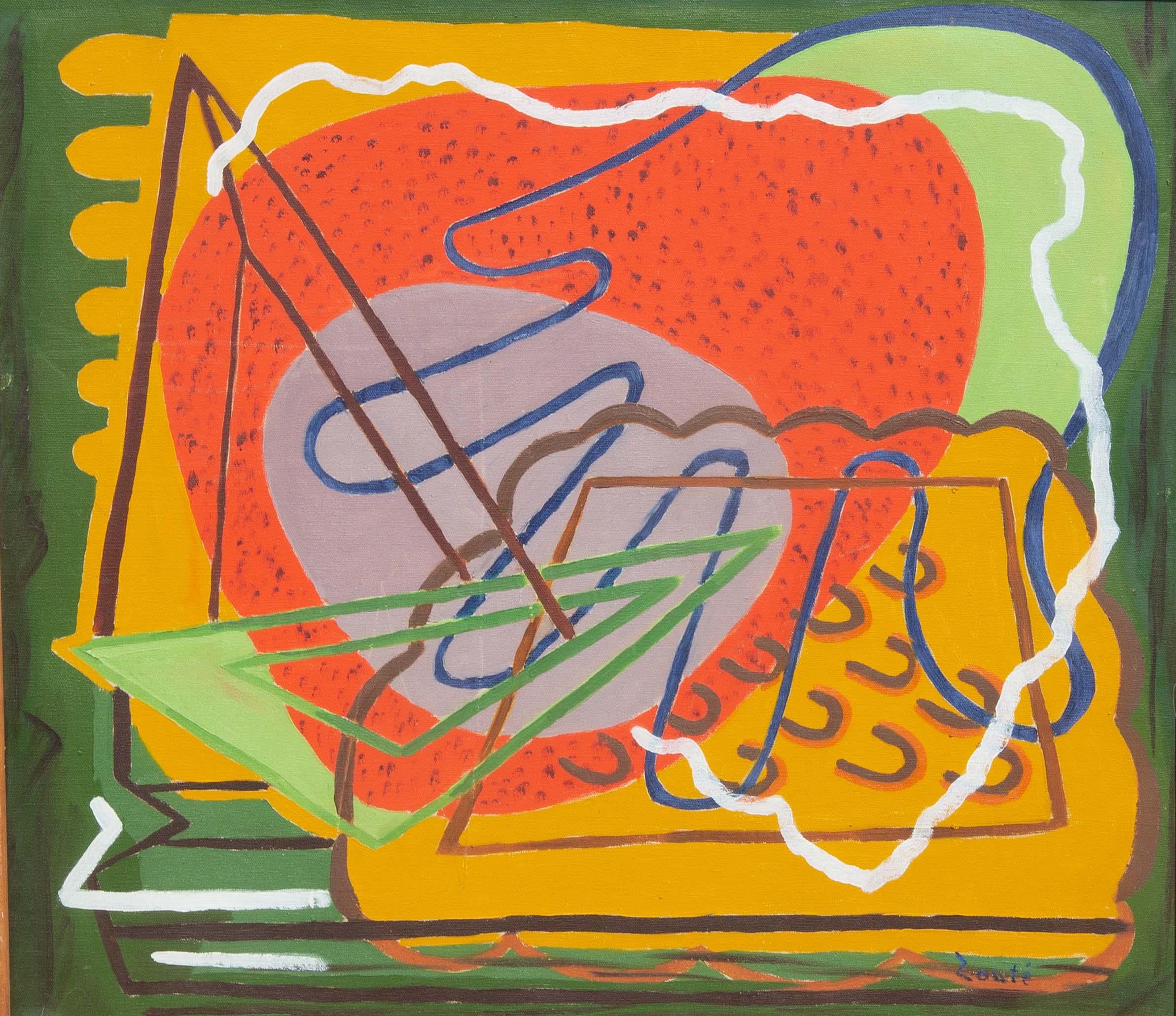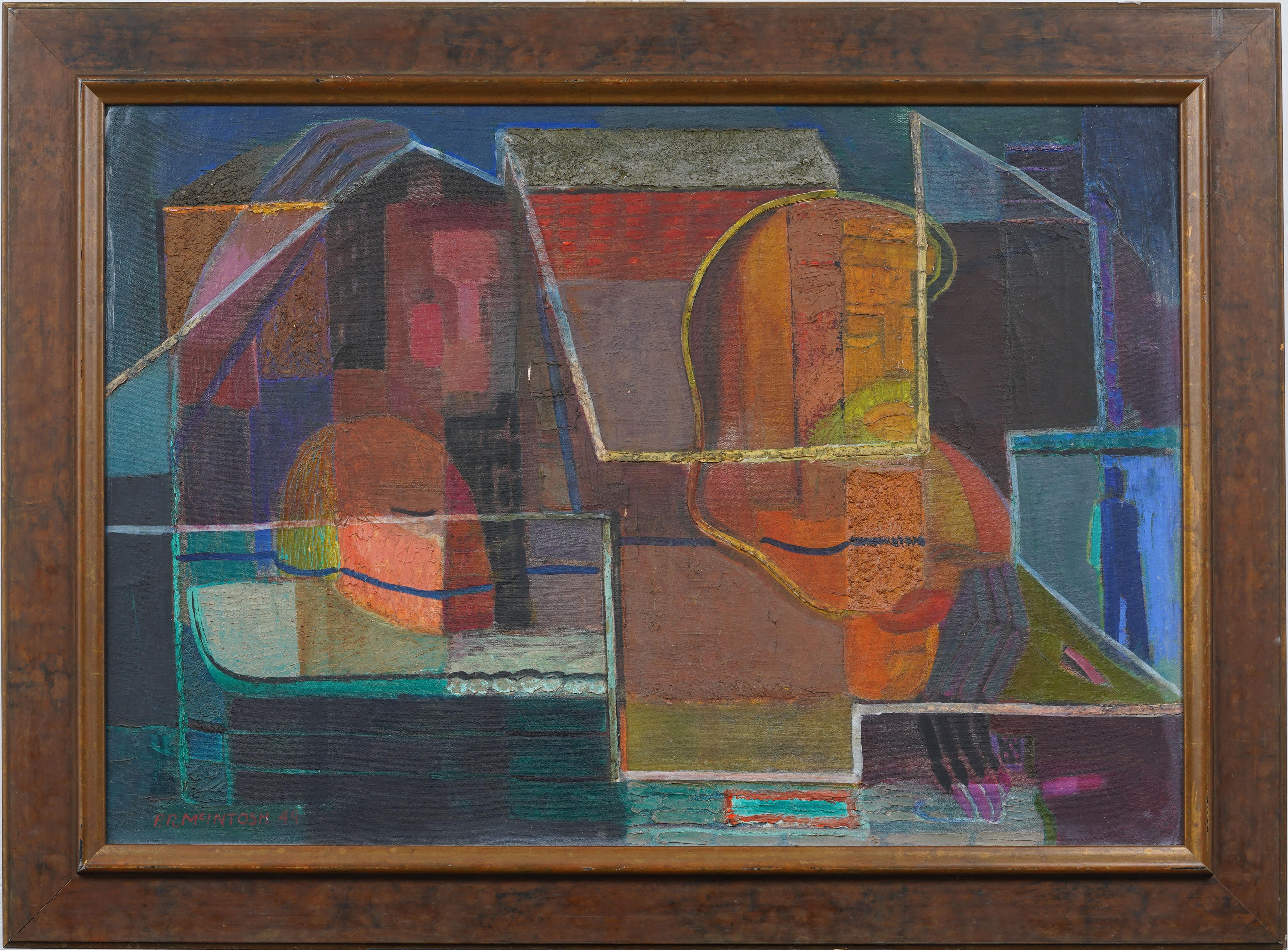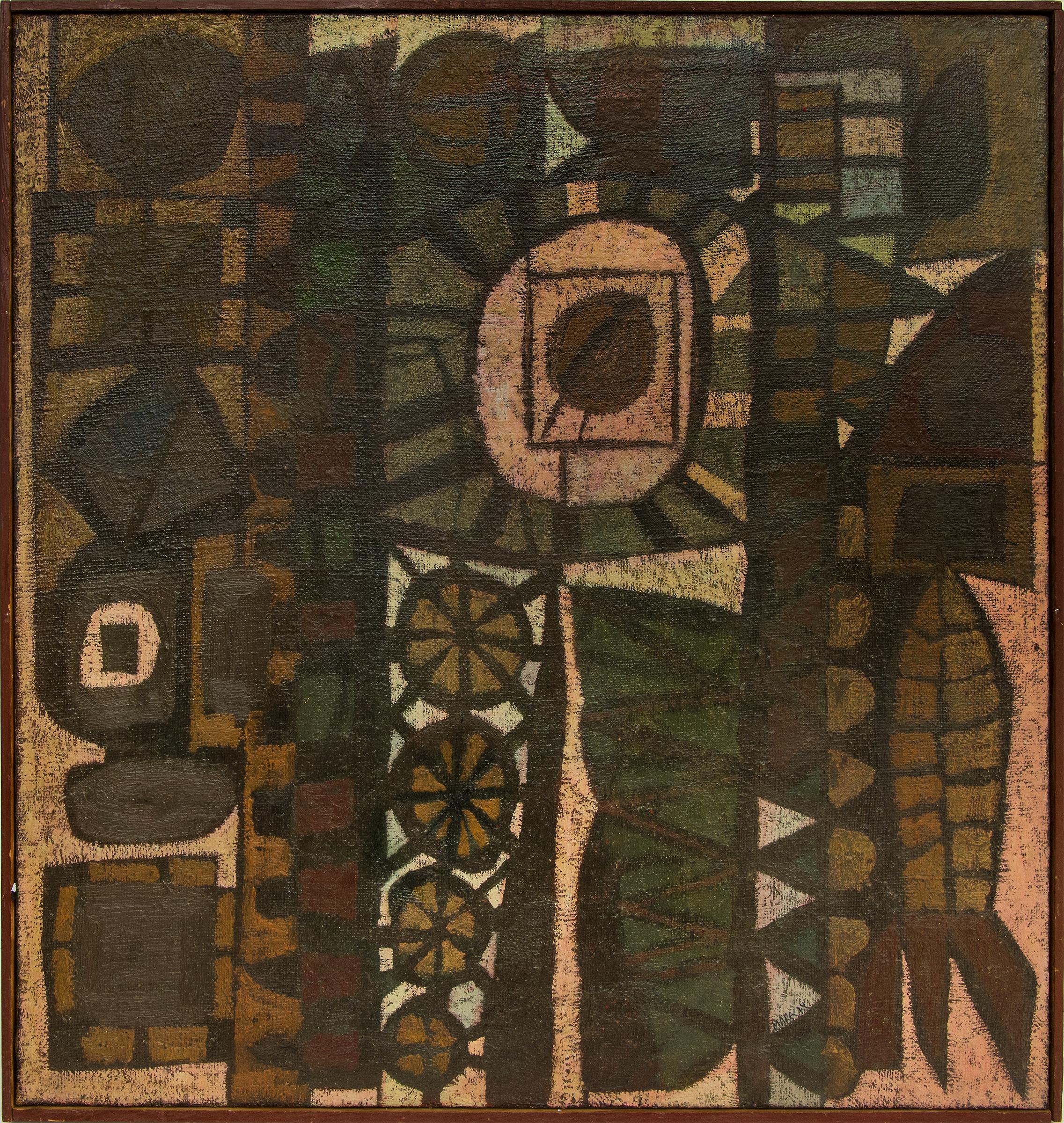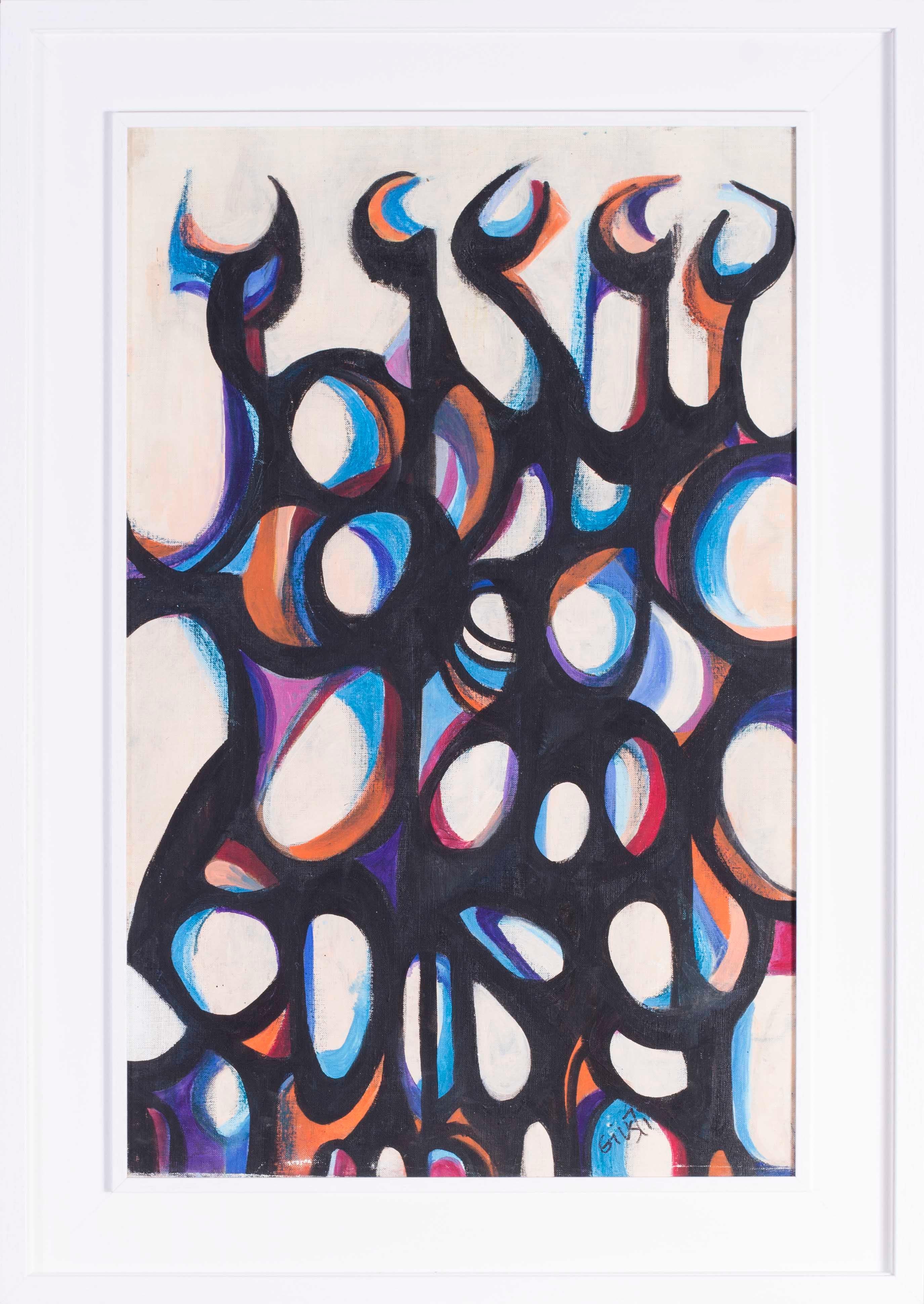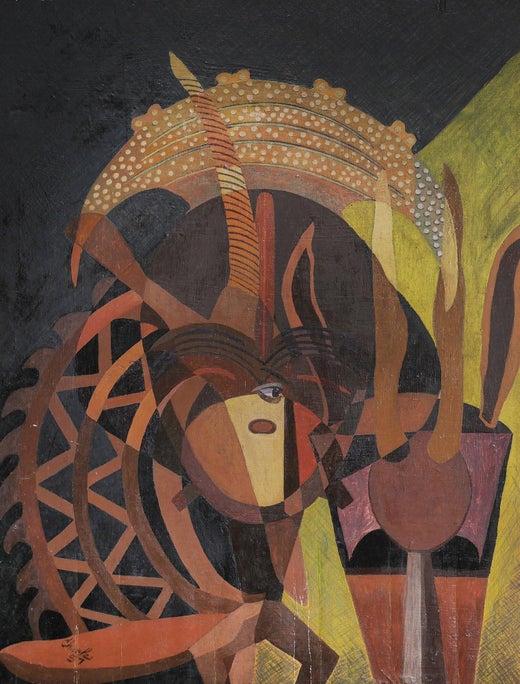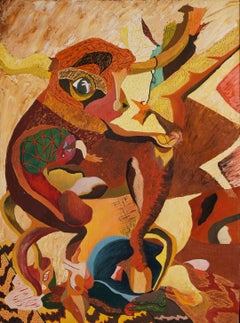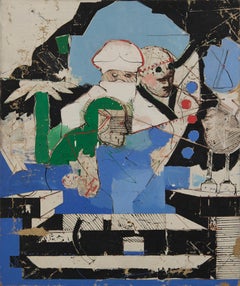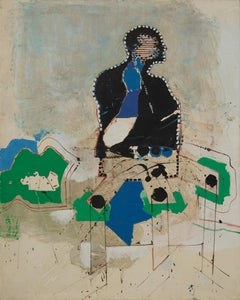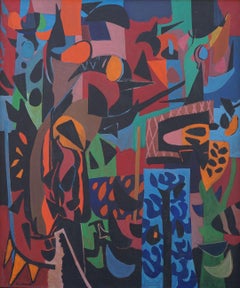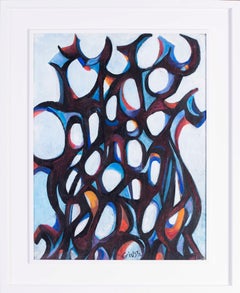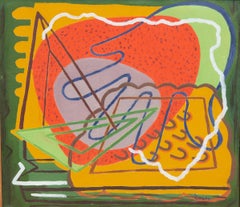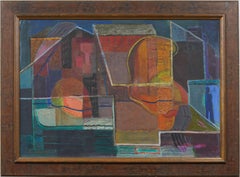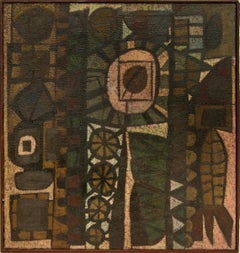Items Similar to Meditation on African Sculpture, mid-century figural abstract painting
Video Loading
Want more images or videos?
Request additional images or videos from the seller
1 of 20
Beni E. KoshMeditation on African Sculpture, mid-century figural abstract painting1957
1957
$5,500
£4,178.15
€4,812.56
CA$7,868.31
A$8,629.44
CHF 4,450.56
MX$103,085.99
NOK 56,446.70
SEK 52,953.41
DKK 35,953.37
About the Item
Beni E. Kosh/Charles Elmer Harris (American, 1917-1993)
Meditation on African Sculpture, 1957
Oil on found wood panel
Signed and dated lower left
20 x 15 inches
Charles Elmer Harris was born in 1917 in Cleveland, Ohio. In the 1960’s, he legally changed his name to Beni E. Kosh or “Son Of Ethiopia”. He was a student of Cleveland artist Paul Travis at the Cleveland Institute of Art and later connected to the “Sho Nuff Art Group”, a group of African-American artists, and the Karamu House artist group.
Kosh scarcely ever exhibited or sold his work. It was not until the end of his life that his works were “rediscovered” and amassed recognition.
Kosh’s work is noted in the catalog Yet Still, We Rise: African American Art in Cleveland 1920 – 1970 and included in exhibitions at the Cleveland State University and the Butler Institute of American Art.
The artist died in 1993.
- Creator:Beni E. Kosh (1917 - 1993, American)
- Creation Year:1957
- Dimensions:Height: 20 in (50.8 cm)Width: 15 in (38.1 cm)
- Medium:
- Movement & Style:
- Period:
- Condition:
- Gallery Location:Beachwood, OH
- Reference Number:1stDibs: LU1768210785432
Beni E. Kosh
Charles Elmer Harris was born in 1917 in Cleveland, Ohio. In the 1960’s, he legally changed his name to Beni E. Kosh or “Son Of Ethiopia”. He was a student of Cleveland artist Paul Travis at the Cleveland Institute of Art and later connected to the “Sho Nuff Art Group”, a group of African-American artists, and the Karamu House artist group. Kosh scarcely ever exhibited or sold his work. It was not until the end of his life that his works were “rediscovered” and amassed recognition. Kosh’s work is noted in the catalog Yet Still, We Rise: African American Art in Cleveland 1920 – 1970 and included in exhibitions at the Cleveland State University and the Butler Institute of American Art. The artist died in 1993.
About the Seller
5.0
Platinum Seller
Premium sellers with a 4.7+ rating and 24-hour response times
Established in 1975
1stDibs seller since 2022
39 sales on 1stDibs
Typical response time: <1 hour
- ShippingRetrieving quote...Shipping from: Beachwood, OH
- Return Policy
Authenticity Guarantee
In the unlikely event there’s an issue with an item’s authenticity, contact us within 1 year for a full refund. DetailsMoney-Back Guarantee
If your item is not as described, is damaged in transit, or does not arrive, contact us within 7 days for a full refund. Details24-Hour Cancellation
You have a 24-hour grace period in which to reconsider your purchase, with no questions asked.Vetted Professional Sellers
Our world-class sellers must adhere to strict standards for service and quality, maintaining the integrity of our listings.Price-Match Guarantee
If you find that a seller listed the same item for a lower price elsewhere, we’ll match it.Trusted Global Delivery
Our best-in-class carrier network provides specialized shipping options worldwide, including custom delivery.More From This Seller
View All20th C. Figurative Abstract Painting Cleveland School African American Artist
By Beni E. Kosh
Located in Beachwood, OH
Beni E. Kosh/Charles Elmer Harris (American, 1917-1993)
Untitled
Oil on canvas board
Estate stamped #611 verso
24 x 18 inches
Charles Elmer Harris was born in 1917 in Cleveland, Oh...
Category
20th Century American Modern Figurative Paintings
Materials
Oil
Large Figural Abstract Late 1960s Painting, Mexican American Artist
By Miguel Conde
Located in Beachwood, OH
Miguel Condé (Mexican/American, b. 1939)
Untitled, 1968
Oil on canvas
Signed and dated verso
59.5 x 49.5 inches
Paint loss throughout - please reach out for a thorough condition rep...
Category
1960s Abstract Abstract Paintings
Materials
Oil
Large Figural Abstract Late 1960s Painting, Mexican American Artist
By Miguel Conde
Located in Beachwood, OH
Miguel Condé (Mexican/American, b. 1939)
Untitled, 1968
Oil on canvas
Signed and dated verso
55.25 x 44 inches
Miguel Condé is a Mexican figurative painter, draughtsman, and print m...
Category
1960s Abstract Abstract Paintings
Materials
Oil
Magic Garden, vibrant mid-century abstract expressionist colorful geometric work
By Richard Andres
Located in Beachwood, OH
Richard Andres (American, 1927-2013)
Magic Garden, c. 1962
oil on canvas
signed lower left, signed and titled verso
50 x 42 inches
Richard Andres was born in Buffalo, New York in 19...
Category
1960s Abstract Expressionist Abstract Paintings
Materials
Oil
Large Black Figural Abstract 1960s Painting, Mexican American Artist
By Miguel Conde
Located in Beachwood, OH
Miguel Condé (Mexican/American, b. 1939)
Untitled, 1968-9
Oil on canvas
Signed and dated verso
44.25 x 55 inches
Miguel Condé is a Mexican figurative painter, draughtsman, and print...
Category
1960s Abstract Abstract Paintings
Materials
Oil
Garden, Abstract Expressionist Mid-Century Modern geometric work
By Richard Andres
Located in Beachwood, OH
Richard Andres (American, 1927-2013)
Garden, 1972
acrylic on canvas
signed, dated and titled verso
59.5 x 50 inches
Richard Andres was born in Buffalo, New York in 1927. A graduate of the Cleveland Institute of Art in 1950, he was immediately drafted and served for two years in the army as a mural painter. He received his Master of Arts from Kent State in 1961. A frequent exhibitor at galleries and museums and winner of multiple May Show prizes, Andres taught art in the Cleveland Public Schools for 28 years, as well as teaching the University of Buffalo, the Cleveland Institute of Art and the Western Reserve University.
Very little in Richard Andres’ childhood would have predicted his love of classical music, mid-century-modern architecture and certainly not his lifelong passion for art and in particular abstract art. Richard’s father, Raymond, had no more than a third-grade education, and his mother, Clara, was one of thirteen children – only three of whom lived into adulthood and none of whom attended high school.
They lived, when Richard was a boy, in a dingy area of Buffalo, NY in a walk-up apartment situated above a tavern. Raymond and Clara supplemented the income from their factory jobs in the bar downstairs with Raymond playing ragtime on the piano and Clara serving drinks. This often left Richard and his two older brothers at home alone to fend for themselves. The two older boys, Raymond and Russell, were - unlike Richard- rather rough and tumble and entertained themselves with stickball, boxing and the like. Richard, on the other hand, from a very young age liked to draw, or better yet even, to paint with the small set of watercolors he received for Christmas one year. Paper, however, at the height of the depression, was hard to come by. Luckily, Clara used paper doilies as decoration for the apartment and Richard would contentedly paint and then cut up doilies, gluing the pieces together to create collages.
At eight-years-old, he discovered the Albright-Knox Museum (then known as the Albright Art Gallery) and spent several hours a week there studying the paintings. He was particularly fond of Charles Burchfield‘s landscapes, enamored with their ‘messiness’ and thinking that they somehow captured more ‘feeling’ than works he was previously familiar with. For his tenth Christmas, he asked for and received a ‘how-to’ paint book by Elliot O’Hare. Through this self-teaching, he assembled the portfolio needed for acceptance to Buffalo Technical High School where he studied Advertising Arts. In his Junior year, he was encouraged to enter a watercolor painting, “Two Barns,” in the national 1944-45 Ingersoll Art Award Contest and was one of twelve grand prize winners – each one winning one hundred dollars. More importantly the painting was exhibited at the Carnegie Institute Galleries, which resulted in his winning a national scholarship to the Cleveland School of Art (The Cleveland Art Institute).
He flourished at the art school under the tutelage of faculty members such as Carl Gaertner, as well as that of visiting artists such as William Sommer and Henry George Keller. He would say in later years that Gaertner, in particular, influenced his attitude toward life as well as art. “Gaertner,” Andres said, “believed that there was no need to be a ‘tortured artist’, that an artist should rather enjoy beauty, family, and life in general.” Free to spend his days as he chose, he wandered the Cleveland Art Museum for most of the hours he was not attending classes or painting; the remaining time was spent drinking coffee at a local hangout with art school friends – which is where he met fellow Henry Keller scholarship winner, Avis Johnson. Richard was immediately smitten with Avis, but being rather shy, it took him the entire summer of 1948 to build up his courage to ask her out. Over that summer he ‘thought about Avis’ and worked in a diner to save money. He also used the hundred-dollar prize money won in High School to visit the first Max Beckmann retrospective in the United States at the City Art Museum in St. Louis. Over a half century later he spoke of that exhibit with a reverence usually reserved for spiritual matters, “I walked in and it was like nothing I had ever seen before... the color...It just glowed.”
Returning to campus in the Fall, the first thing he did was go to the coffee shop in hopes of finding Avis. He did, and she, upon seeing him, realized that she was also smitten with him. They quickly became known as ‘the couple’ on campus, and a year later, with Richard being drafted for the Korean war, they were quickly married by a Justice of the Peace, celebrating after with family at Avis’s Cleveland home. As a gift, faculty member John Paul Miller...
Category
1970s Abstract Expressionist Abstract Paintings
Materials
Acrylic
You May Also Like
20th Century French abstract oil painting by Giusti 'Femmes Africaines'
By Frederique Giusti
Located in Petworth, West Sussex
Frederique Giusti (French, b. 1925)
Femmes Africaines
Oil on board
Signed ‘Giusti’ (lower edge)
24 x 18.3/8 in. (61 x 46.7 cm.)
Category
20th Century Abstract Expressionist Abstract Paintings
Materials
Canvas, Oil
$1,205 Sale Price
20% Off
Abstract Composition by Zoute (Leon Salter) Mid Century
Located in Rochester, NY
Abstract Modernist oil painting by Zoute. Oil on canvas mounted on board. Painted in circa 1940's.
Zoute (Born-Leon Salter, 1903-1976) was self-taught and well exhibited during his l...
Category
Mid-20th Century Abstract Abstract Paintings
Materials
Canvas, Oil
"Metropolitan Abstraction" Signed Mid Century Cubist Architectural Abstraction
Located in Buffalo, NY
Antique American abstract cubist street scene oil painting. Oil on board. Framed. Signed. Measuring: 31 by 42 inches overall, and 25 by 36 painting alone. In excellent original con...
Category
1940s Modern Abstract Paintings
Materials
Oil, Board
“Pods” Abstract Oil Painting by Edward Marecak Mid-Century Modern Art
By Edward Marecak
Located in Denver, CO
“Pods” is an original mid-century modern abstract oil painting by renowned 20th-century Denver artist Edward Marecak (1919–1993). This striking composition showcases Marecak’s signat...
Category
Mid-20th Century Abstract Abstract Paintings
Materials
Oil
French 20th Century abstract painting by Frederick Giusti 'Femmes Africaines II'
By Frederique Giusti
Located in Petworth, West Sussex
Frederique Giusti (French, b. 1925)
Femmes Africaines II
Oil on canvas laid down on board
Signed ‘Giusti’ (lower right)
29 x 18.3/4 in. (73.8 x 47.3 ...
Category
20th Century Abstract Expressionist Abstract Paintings
Materials
Canvas, Oil
Abstract Mid 20th Century WPA Non Objective American Modernism New Hope Modern
By Louis Stone
Located in New York, NY
Abstract Mid 20th Century WPA Non Objective American Modernism New Hope Modern.mixed media. 21 x 16 (sight). Housed in a hand carved frame.
Louis King Stone ...
Category
1940s American Modern Mixed Media
Materials
Gouache, Board
More Ways To Browse
African American Art
African Oil Paintings
African American Artist Still Life
Vintage African American Art
Framed African Art
Africa Abstract Paintings
Mid Century African Sculpture
African Art Abstract Painting
African Sculpture Abstract
Meditation Sculpture
Kosh Kosh
Blue Color Field
Oil Painting Expressionism
Vintage Feminist Art
Large Used Safes
Blue Dancers
New Haven Ct
Pittsburgh Pa
